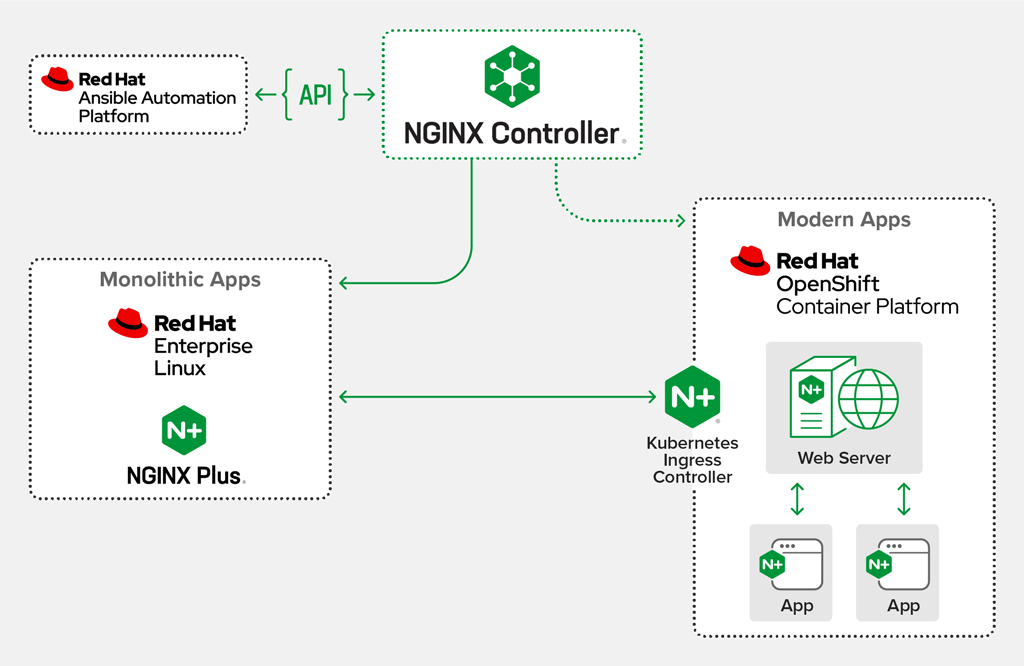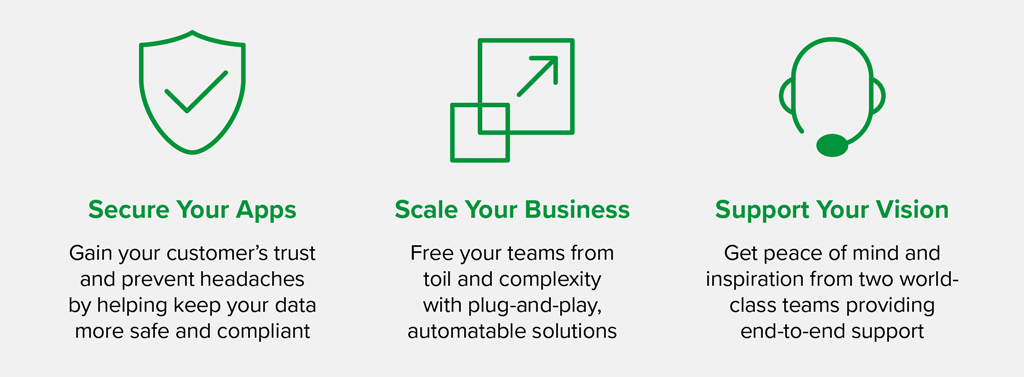At NGINX (now a part of F5), we’re seeing a shift in what customers expect from their technology providers. We see code as the literal and figurative connective tissue that builds communities, drives innovation, and tells stories. It only makes sense for us to invest in a relationship with another open‑source–loving company known across the globe: Red Hat.
NGINX is making one of its deepest investments in optimizing for the Red Hat platforms. We want to reduce friction for our customers by enabling seamless integration with some of the most popular Linux, automation, and container platforms: Red Hat Enterprise Linux, Red Hat Ansible Automation Platform, and Red Hat OpenShift Container Platform.
What is the value to you of an enhanced relationship between Red Hat and NGINX? Secure, scalable, and supported application delivery – no matter where you are on the journey from monolithic apps to microservices. You can gain greater visibility, control, and speed to get the most out of your traditional apps, manage a hybrid portfolio, or enable automation…or all the above. Dive in to learn more about our solutions!

Get Enterprise‑Grade Kubernetes
with Red Hat OpenShift and NGINX Plus Ingress Controller for Kubernetes
Containers are no longer just for early adopters and those on the bleeding edge of technology. In the race to deliver apps faster, organizations are modernizing app portfolios with microservices and entrusting production workloads to containers. But despite being mainstream, containers can drive higher risks and costs because of issues around security and complexity. Further, the need for cultural changes within development teams remains the top challenge in using and deploying containers, according to the 2019 survey conducted by the Cloud Native Computing Foundation (CNCF).
One way to address these challenges is by using a container management platform that embraces common, open standards rather than building a bespoke implementation. Red Hat OpenShift is the industry’s most comprehensive enterprise Kubernetes platform and brings powerful tools and services to bear for container management. With full support and the option for managed service, users receive peace of mind knowing that Red Hat is backing their container platform from a design, support, and troubleshooting standpoint.
The Value of OpenShift + NGINX Plus Ingress Controller for Kubernetes
Help your teams solve security, complexity, and cultural challenges! With the NGINX Ingress Operator for OpenShift, you can use NGINX Plus Ingress Controller alongside the default OpenShift router. We started with the NGINX Open Source Ingress controller – the most widely deployed on the planet – and built a fully supported version with enterprise‑grade features that enable far more than just traffic management for your containers. With a couple of keystrokes, your developers can improve testing so that bad code doesn’t get into production, and immediately start getting better data about app functionality and performance.
Check out our documentation and the GitHub repo, and then get started with the NGINX Ingress Operator for OpenShift 4.3+.
Get Faster Release Cycles
with Red Hat Ansible Automation Platform and NGINX Controller
Did you know that 28% of enterprises have adopted a weekly app release cycle and 27% are releasing app updates every day? Achieving this kind of speed while maintaining the quality consumers expect is possible only with automation. The first step in automating app lifecycle management is the creation of a continuous integration/continuous delivery (CI/CD) workflow. These workflows usually begin as manual processes, and little by little, human hands are swapped out for code. The result is a partially or fully automated CI/CD workflow that reduces errors and downtime so that developers can focus on creating business value instead of troubleshooting broken apps.
Frequently, configuration management, application deployment, and resource provisioning are the most common things automated by any organization. Red Hat Ansible Automation Platform is one of the most popular solutions for this type of automation. Ansible has a short learning curve, so teams can more quickly automate repetitive app lifecycle tasks. Plus, its agentless design means you get a more efficient ecosystem with enhanced security.
The Value of Ansible + NGINX Controller
You can reduce your app deployment time from months to minutes with our control plane solution: NGINX Controller. How? In the same way the Ansible Automation Platform helps you manage your app workflows, NGINX Controller helps you manage your NGINX Plus instances in multiple environments, including Red Hat Enterprise Linux. We baked in the ability to automate your NGINX environment using a RESTful configuration API, and we just released the Ansible Collection for NGINX Controller.
This collection enables you to add NGINX Controller into your regular workflows so that your developers can automate the toil, including ephemeral API token generation, managing certificate lifecycles, and configuration of Controller objects (gateways, applications, and components). We see the collection as a starting place that will grow over time through efforts from NGINX and the community.
Learn how to get started and then check out our certified collection in Ansible Automation Hub or the upstream, community version in Ansible Galaxy. If you aren’t already using NGINX Controller, get started by requesting a free trial.
Get Secure Monolithic Apps with Red Hat Enterprise Linux and NGINX Plus
Organizations are modernizing how they write and deliver apps, but that doesn’t mean monolithic apps are going away overnight – or even this year. Unless you’re a digital native, some or all of your apps are probably monolithic. But legacy apps often have security and performance issues, so you need an ecosystem that maximizes app potential while easing the transition to microservices when the time is right.
DevOps, NetOps, and SecOps love Linux for the security features, reliability, and flexibility it brings to enterprise systems, not to mention the number of supported languages, fast updates, and customization. When it comes to enterprise operating systems, Red Hat has dominated enterprise Linux for years with Red Hat Enterprise Linux (RHEL). Its production‑ready, packaged, and supported version of Linux makes it a compelling choice for organizations looking for enhanced security, simplicity, and peace of mind. Even better, it can be deployed anywhere, including on an OpenShift cluster while also forming the Linux backbone of Red Hat’s Kubernetes platform.
The Value of RHEL + NGINX Plus
What if you could address your app security and compliance needs with just two products? Alongside RHEL, NGINX Plus is an excellent choice for organizations with high security and compliance needs, such as government, healthcare, and finance. NGINX offers proactive vulnerability patching, which means when there is a bug looking to exploit web servers (remember Heartbleed?), we’ll send you a patch or push out a configuration to keep your ecosystem secure.
NGINX Plus can also handle authentication and SSL for your all legacy apps, which allows you to automate security policies and have clear visibility into who can access your data. If the Federal Information Processing Standard (FIPS) is important to your organization, rest assured you can easily deploy NGINX Plus in a FIPS‑compliant fashion and verify that FIPS operations are correctly performed.
Because we see RHEL as a premium platform, we work closely with the RHEL team to ensure that NGINX Plus is available on the same day as new RHEL releases. Once you install NGINX Plus on RHEL, upgrades become the same as for any other piece of Red Hat software, meaning you can download and install updates natively within RHEL. Together, our solutions will help you deliver monolithic apps quickly and securely while avoiding costly infrastructure lock‑in.
See NGINX Plus Technical Specifications to see which RHEL versions are currently supported and start a free 30-day trial of NGINX Plus contact us to discuss your use cases.
The Value: Secure, Scalable, and Supported Application Delivery
With Red Hat and NGINX working together, you get the best from both our companies! Together we:



